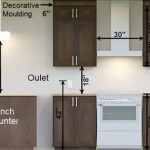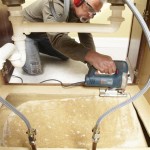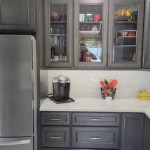How To Remove Scratches From Kitchen Cabinets
Kitchen cabinets, subjected to daily wear and tear, often develop unsightly scratches that detract from their appearance. Fortunately, several methods exist for repairing these blemishes, ranging from simple touch-ups to more involved restoration techniques. Choosing the right approach depends on the severity of the scratch and the cabinet's finish.
Assessing the Scratch
Before attempting any repair, it is crucial to assess the damage. The depth and extent of the scratch will dictate the appropriate course of action.
- Superficial Scratches: These are minor blemishes affecting only the clear coat or the very top layer of the finish. They often appear as light, hairline marks.
- Moderate Scratches: These penetrate deeper into the finish, revealing the color or wood grain beneath.
- Deep Scratches: These reach the underlying wood, potentially causing dents or chips. They require more extensive repair work.
Repairing Superficial Scratches
Superficial scratches can often be addressed with simple cleaning and polishing techniques. These methods aim to fill the microscopic grooves of the scratch and restore the cabinet's sheen.
- Cleaning: Begin by thoroughly cleaning the affected area with a mild soap and water solution to remove any dirt or grease. Dry the surface completely.
- Cabinet Creams: These products, specifically designed for furniture, contain oils and waxes that can fill minor scratches and restore luster. Apply the cream according to the manufacturer's instructions.
- Cooking Oil: For very light scratches, rubbing a small amount of cooking oil, such as vegetable or mineral oil, onto the scratch can sometimes provide a temporary fix. Buff gently with a soft cloth.
Repairing Moderate Scratches
Moderate scratches necessitate slightly more involved treatments that fill and conceal the damage.
- Touch-Up Markers: Furniture touch-up markers are available in a variety of colors and finishes. Choose a marker that closely matches the cabinet's color and apply it carefully to the scratch, filling the groove. Let it dry completely.
- Wax Sticks/Crayons: Similar to touch-up markers, wax sticks or crayons offer a more substantial fill for deeper scratches. Rub the wax stick over the scratch, ensuring it fills the void. Buff away any excess wax with a soft cloth.
- Wood Filler: For scratches that have removed some of the wood finish, wood filler can be used to level the surface. Apply the filler carefully, allow it to dry, and then sand it smooth before applying a matching finish.
Repairing Deep Scratches
Deep scratches often require more extensive repairs involving sanding, staining, and refinishing.
- Sanding: Lightly sand the damaged area with fine-grit sandpaper to smooth the edges of the scratch and remove any loose splinters. Be careful not to sand too deeply.
- Wood Filler/Putty: Fill the scratch with wood filler or putty. Allow it to dry completely and then sand it smooth, blending it with the surrounding surface.
- Staining: If the scratch has exposed bare wood, apply a stain that matches the cabinet's finish. Test the stain on an inconspicuous area first to ensure a color match.
- Sealing/Refinishing: Apply a clear sealant or refinisher to protect the repair and restore the cabinet's sheen. Multiple coats may be necessary.
Preventing Future Scratches
Preventing future scratches is always preferable to repairing them. Simple precautions can significantly extend the life and beauty of kitchen cabinets.
- Cleaning Regularly: Regular cleaning with a mild soap and water solution removes grit and grime that can cause scratches.
- Protective Liners: Placing protective liners in drawers and shelves can prevent scratches from cookware and utensils.
- Bumpers: Installing bumpers on cabinet doors and drawers can cushion impact and prevent scratching.
- Caution with Sharp Objects: Exercise caution when using sharp objects near cabinets, and avoid dragging heavy items across their surfaces.
Professional Repair
For extensive damage or for those uncomfortable with DIY repairs, seeking professional assistance is recommended. A professional furniture restorer possesses the expertise and tools to effectively address complex repairs and achieve seamless results.
- Assessment: A professional will thoroughly assess the damage and recommend the most appropriate course of action.
- Specialized Techniques: Professionals have access to specialized tools and techniques, such as lacquer or varnish application, that can restore cabinets to their original condition.
- Color Matching: They are skilled in accurately matching colors and finishes to create a seamless repair.
Choosing the Right Approach
Selecting the appropriate repair method depends on the severity of the scratch and the cabinet's finish. Consider the type of finish (painted, stained, lacquered), the depth of the scratch, and your comfort level with DIY repairs when making your decision.
- Minor Scratches: Simple cleaning, cabinet creams, or touch-up markers are suitable for minor scratches.
- Moderate Scratches: Wood filler, wax sticks, or touch-up pens are effective for moderate scratches.
- Deep Scratches: Sanding, staining, and refinishing, or professional restoration, are generally required for deep scratches.

How To Fix Scratched Kitchen Cabinets Infinity

How To Fix Minor And Deeper Scratches On A Wooden Kitchen Cabinet

Scratched And Chipped Kitchen Cabinet Doors Refinishing Touch

3 Ways To Remove A Scratch From Laminate Countertop Wikihow

How To Remove Scratches From Gloss Kitchen Cabinets Effective Techniques

Eliminating Scratches And Blemishes From Wooden Cabinets Furniture Hometalk

How To Remove Scratches From Gloss Kitchen Cabinets Effective Techniques

How To Remove Scratches From Kitchen Worktops

5 Fixes Easily Update Worn Scratched Kitchen Cabinets

How To Re Cabinets Bob Vila S Blogs
Related Posts








